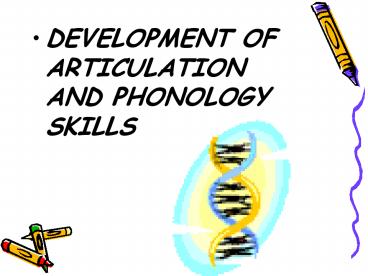DEVELOPMENT OF ARTICULATION AND PHONOLOGY SKILLS - PowerPoint PPT Presentation
1 / 30
Title:
DEVELOPMENT OF ARTICULATION AND PHONOLOGY SKILLS
Description:
II. INFANT SPEECH PRODUCTION. Stage 1 Phonation Stage Birth-1 mo. Stage 2 Cooing and Gooing 2-3 mos. Stage 3 Exploration and Expansion-4-6 mos. ... – PowerPoint PPT presentation
Number of Views:1677
Avg rating:3.0/5.0
Title: DEVELOPMENT OF ARTICULATION AND PHONOLOGY SKILLS
1
- DEVELOPMENT OF ARTICULATION AND PHONOLOGY SKILLS
2
Some information from
- Bernthal, J.E., Bankson, N.E., Flipsen, P.
(2009). Articulation and phonological disorders
Speech sound disorders in children (6th ed.).
Boston Pearson Education.
3
Other specific sources
- Justice, L.M. (2010). Communication sciences and
disorders A contemporary perspective (2nd ed.).
Boston Allyn Bacon. - Nelson, N.W. (2010). Language and literacy
disorders Infancy through adolescence. Boston
Allyn Bacon. - Kaderavek, J. (2011). Language disorders in
children Fundamental concepts of assessment and
intervention. Boston Allyn Bacon. - Owens, R.E., Metz, D.E., Farinella, K.A.
(2011). Introduction to communication disorders
A lifespan evidence-based perspective (4th ed.).
Boston Pearson Publishing.
4
I. DEVELOPMENT IN INFANTS
- A. Introduction
5
II. INFANT SPEECH PRODUCTION
- Stage 1Phonation StageBirth-1 mo.
6
Owens, Metz, Farinella 2011
7
Owens, Metz, Farinella, 2011 (continued)
8
(No Transcript)
9
- Stage 2Cooing and Gooing2-3 mos.
- Stage 3Exploration and Expansion-4-6 mos.
10
- Stage 4Canonical/Reduplicated Babbling7-9 mos.
- Stage 5Variegated Babbling10-12 mos.
11
III. TRANSITION PERIOD
- Prelinguistic?linguistic phonological development
- Protowords/vocables
12
IV. FIRST REAL WORDS MEANINGFUL SPEECH
13
V. SOUND SYSTEM DEVELOPMENT
- A. Single Phonemes
- 1. Cross-sectional studies
- Age of development 50 of children produce
sound accurately - Age of mastery 75-90 of children produce sound
accurately - By 30 years /h, w, m, n, b, p, f/
- By 40 years /d, t, k, g, ng j/
- By 60 years /l, dj, ch, sh, v/
- By 80 years everything!
- 2. Longitudinal studies
14
B. Consonant Clusters
- Very little information
- Earliest
- Latest
15
C. Vowels
16
VI. COMMON ERRORS
- A. Liquids
- B. Nasals
17
C. Alveolar and Palatal Fricatives and Affricates
18
D. Glides
19
E. Labial and Dental Fricatives
20
F. Stops
21
G. Consonant Clusters
- Obstruents stops, fricatives, affricates
(everything except glides, liquids, and nasals) - usually clusters are reduced to the
obstruent - Obstruent /w/ clusters reduced to the obstruent
- tin/twin kak/quack
- Obstruent /l/ clusters reduced to the obstruent
- Fing/fling gad/glad
22
- Obstruent /r/ clusters reduced to obstr.
- Clusters with /s/ consonant reduced to /w/,
nasal, or stop component of the cluster - Three-member clusters (e.g., squirrel) usually
reduced to the stop
23
VII. INTELLIGIBILITY OF SPEECH
- (please memo for test chart p. 187)
24
VIII. NORMAL DEVELOPMENT PHONOLOGICAL
PROCESSES
- (chart p. 185- know in detail for test)
25
IX. SCHOOL YEARS PHONOLOGICAL AWARENESS
26
(No Transcript)
27
Aspects of phonological awareness
- Sound blending
- Rhyming
- Alliteration
28
- Phoneme isolation
- Sound segmentation
- Syllable identification
29
Justice, Gillon, Schuele, 2009 Phonological
awareness Description, assessment, and
intervention (In Bernthal et al.)
30
Justice et al 2009 stated that































